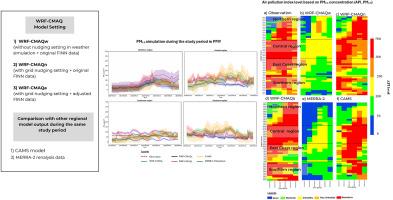Sensitivity analysis of WRF-CMAQ model in predicting PM2.5 and O3 concentration in Peninsular Malaysia: 2019 transboundary burning smoke case study
IF 3.7
2区 环境科学与生态学
Q2 ENVIRONMENTAL SCIENCES
引用次数: 0
Abstract
The high PM2.5 concentrations significantly influence the air quality in the Maritime Continent region, especially in Peninsular Malaysia (PMY), which is affected by the annual burning season. However, the 2019 pollution case is unique due to the presence of a positive Indian Ocean dipole (pIOD) with a weak El Niño, which influenced the transport of pollutants toward PMY. This work aims to evaluate the ability of the numerical chemical weather prediction model (WRF-CMAQ) by performing a sensitivity analysis to reproduce the air quality during this event. Two model settings were studied: weather nudging and the burning emission amount of the fire inventory from NCAR (FINN). Three cases were established: 1) WRF-CMAQw (without nudging setting and with original fire emission), 2) WRF-CMAQn (with nudging setting and with original fire emission), and 3) WRF-CMAQa (with nudging setting and adjusted fire emission) to predict the PM2.5 concentration in PMY during the 2019 transboundary smoke event. The weather (temperature and wind profile) simulation results showed that WRF-CMAQa and WRF-CMAQn agreed up about 95 % and WRF-CMAQw agreed up to 93 % when compared with ground weather stations based on the statistical evaluation of correlation coefficient, bias, and error measures. For air quality, overall, WRF-CMAQa (87.23 %) demonstrated better performance compared to WRF-CMAQw (62.41 %) and WRF-CMAQn (78.72 %) in predicting the ground PM2.5. However, the diurnal prediction during the transboundary smoke event remains weak. For O3 concentration, the model performance agreement was quite low for all simulations. However, WRF-CMAQa could predict about 44.76 % compared to WRF-CMAQn (26.66 %) and WRF-CMAQw (41.90 %) in overall model performance, and all simulations managed to capture the diurnal trend of O3 when compared with ground observation station data. In conclusion, the sensitivity study on the weather and chemical prediction model, especially WRF-CMAQ, could help improve the air quality prediction system in PMY during the recurrence of transboundary smoke events.

WRF-CMAQ模型预测马来西亚半岛PM2.5和O3浓度的敏感性分析——以2019年跨境燃烧烟雾为例
高PM2.5浓度显著影响了海洋大陆地区的空气质量,特别是马来西亚半岛(PMY),该地区受到每年的燃烧季节的影响。然而,2019年的污染案例是独一无二的,因为存在一个具有弱El Niño的印度洋正偶极子(pIOD),这影响了污染物向PMY的运输。本工作旨在评估数值化学天气预报模式(WRF-CMAQ)的能力,通过进行敏感性分析来重现该事件期间的空气质量。研究了两种模型设置:天气推力和NCAR (FINN)火灾清单的燃烧排放量。建立了WRF-CMAQw(无轻推设置并具有原始火灾排放)、WRF-CMAQn(具有轻推设置并具有原始火灾排放)和WRF-CMAQa(具有轻推设置并调整了火灾排放)3个案例来预测2019年跨境烟雾事件期间PMY PM2.5浓度。基于相关系数、偏置和误差度量的统计评价,WRF-CMAQa和WRF-CMAQn与地面气象站的天气(温度和风廓线)模拟结果的一致性约为95%,WRF-CMAQw的一致性高达93%。对于空气质量,总体而言,WRF-CMAQa在预测地面PM2.5方面的表现优于WRF-CMAQw(62.41%)和WRF-CMAQn(78.72%)。然而,在跨界烟雾事件期间的日预报仍然很弱。对于O3浓度,所有模拟的模型性能一致性都很低。与WRF-CMAQn(26.66%)和WRF-CMAQw(41.90%)相比,WRF-CMAQa模型的总体预测能力约为44.76%,与地面观测站数据相比,所有模拟都能较好地捕捉到O3的日变化趋势。综上所述,对天气和化学预报模式的敏感性研究,特别是对WRF-CMAQ模式的敏感性研究,有助于完善越界烟雾事件再次发生时PMY空气质量预报系统。
本文章由计算机程序翻译,如有差异,请以英文原文为准。
求助全文
约1分钟内获得全文
求助全文
来源期刊

Atmospheric Environment
环境科学-环境科学
CiteScore
9.40
自引率
8.00%
发文量
458
审稿时长
53 days
期刊介绍:
Atmospheric Environment has an open access mirror journal Atmospheric Environment: X, sharing the same aims and scope, editorial team, submission system and rigorous peer review.
Atmospheric Environment is the international journal for scientists in different disciplines related to atmospheric composition and its impacts. The journal publishes scientific articles with atmospheric relevance of emissions and depositions of gaseous and particulate compounds, chemical processes and physical effects in the atmosphere, as well as impacts of the changing atmospheric composition on human health, air quality, climate change, and ecosystems.
 求助内容:
求助内容: 应助结果提醒方式:
应助结果提醒方式:


